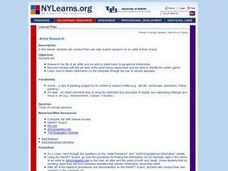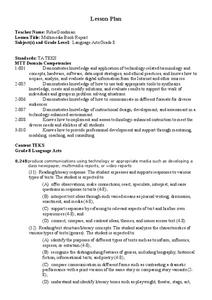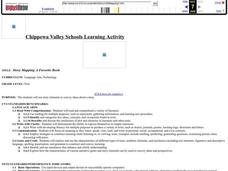Curated OER
Trees, Trees, Trees! - Adopt A Tree
Students adopt a tree, take a bark rubbing from that tree, and conduct research about that type of tree. They write an original piece about their tree using three facts and in a genre of their choice.
Curated OER
Graphic Novel/Comics with Josh Elder
Students read about graphic novels and complete related activities. For this graphic novels lesson, students read about the genre and author Josh Elder. Students complete novel analysis activities for the lesson.
Curated OER
Artist Research
Students research an artist of their choice on the internet. They are provided with questions (worksheets included with the lesson) as a guide for their research. Students choose an artwork by their artist to critique.
Curated OER
Finding Problems In A Story
Students categorize information into a problem/solving chart and examine the value of using a diary. In this problem solving and diary lesson, students read portions of Dear Mr. Henshaw, while they investigate the importance of keeping a...
Curated OER
Writing: Narrative, Expository, Persuasive, and Descriptive
If you are interested in having a basic framework for teaching expository, narrative, persuasive, and descriptive writing, this resource may help; however, you will have to find information on the different forms of writing to share with...
Syracuse City School District
Summary of Fiction and Non-Fiction Text
Somebody Wanted But So Then (SWBST)? Yes! Here's a great strategy for teaching young readers how to summarize narrative text. In addition, the packet includes exercises that show kids how to summarize nonfiction text using the classic...
Curated OER
Character Traits: Yang the Youngest and His Terrible Ear
Lensey Namioka’s Yang the Youngest and His Terrible Ear provides an opportunity for young readers to observe how writers bring their characters to life. Each class member selects a character to trace through the novel, recording...
Curated OER
Learning Life Lessons through Fables
Explore a variety of fables to learn life's lessons through engaging stories. Add rigor to the learning process with activities that include matching a a fable to the story's moral, short answer exit slips, and a three-column graphic...
Houghton Mifflin Harcourt
Grade 4 Reading Item Specifications
Is it the end of the school year and you're in need of test practice? Use a set of reading passages to challenge fourth graders to answer questions based on what they read. Some of the questions require readers to compare and contrast a...
Curated OER
Analyzing the Use of Irony in a Short Story
Ninth graders examine how literature connects to real-life and see how irony aids in the development of theme. They read Shirley Jackson's The Lottery, and discuss elements of foreshadowing and situational irony. Then learners will write...
Curated OER
Figurative Language
What is figurative language, and why do we use it? Introduce your high schoolers to some examples and discuss the importance of including this element in your writing. After studying a text and searching for examples, writers will...
Curated OER
Getting to Know You
Students explore the concept of communication. For this communication lesson, students create collages featuring their likes and dislikes. Students present the collages to their classmates.
Shmoop
ELA.CCSS.ELA-Literacy.W.9-10.4
New to teaching and the Common Core? Then you need to check out how the skill W.9-10.4 is broken down into easy-to-understand steps for your learners to dominate and conqueror. Included is a script to present to your class that details...
Curated OER
Multimedia Book Report
Young readers plan and draft a book report focusing on the five key components of a novel: plot, character, setting, conflict, and theme. After completing a story board, pupils then prepare a PowerPoint book report that is shown to the...
Curated OER
Summarizing Key Information
Imagine the surprise when small groups present their Evidence Charts to the class and discover that each group has studied a different version of the Cinderella story. Irish, Ojibwa, Egyptian, Chinese, Korean, Persian, Mexican, and...
Shmoop
ELA.CCSS.ELA-Literacy.W.11-12.4
Although it does not properly address how to use the Common Core standard, this resource does provide a decent writing prompt that explores how minor characters influence Hamlet's decisions throughout the play. The prompt can be used for...
Curated OER
Language Arts: Digital Commercials
Students create commercials using a digital camera. After brainstorming their ideas, they spend three days writing their commercials. Students practice and edit their commercials and then present them for review.
Curated OER
Story Mapping A Favorite Book
First graders create a diagram of a story by using the computer program Kidspiration. In this diagramming lesson plan, 1st graders will pick a book to write about. They then will plug in story elements of the book into the computer...
Curated OER
Medieval and Renaissance Art: Botanical Symbolism
Learners study the significance of flowers in art from two periods. In this Medieval and Renaissance art lesson, students research the presence and meaning of botanical illustrations in twelfth, thirtieth, and fourteenth century...
Curated OER
Madame Bovary by Gustave Flaubert
In this literature worksheet, students respond to 12 short answer and essay questions about Flaubert's Madame Bovary. Students may also link to an online interactive quiz on the novel at the bottom of the page.
Curated OER
Publishing: A Persuasive Essay
Third graders are given an opportunity to create a visual to accompany their presentations of their persuasive essays. They may use the computer or other media as resources.
Curated OER
2105
Learners read excerpts from Jon Scieszka's novel, 2095, prior to presenting their vision of the future in a creative project accompanied by written explanation. They design a museum exhibit which shows a scene from a science fiction book...
Curated OER
Poetry
Students apply reading comprehension skills to poetry and synthesize the information to create a new piece of work.
Curated OER
What's In A Name
Second graders read Chrysanthemum by Kevin Henkes. They then discuss where various names come from. They create a individualized biopoem and publish it on word processing software. Their poems are compiled into a class book and presented...

























